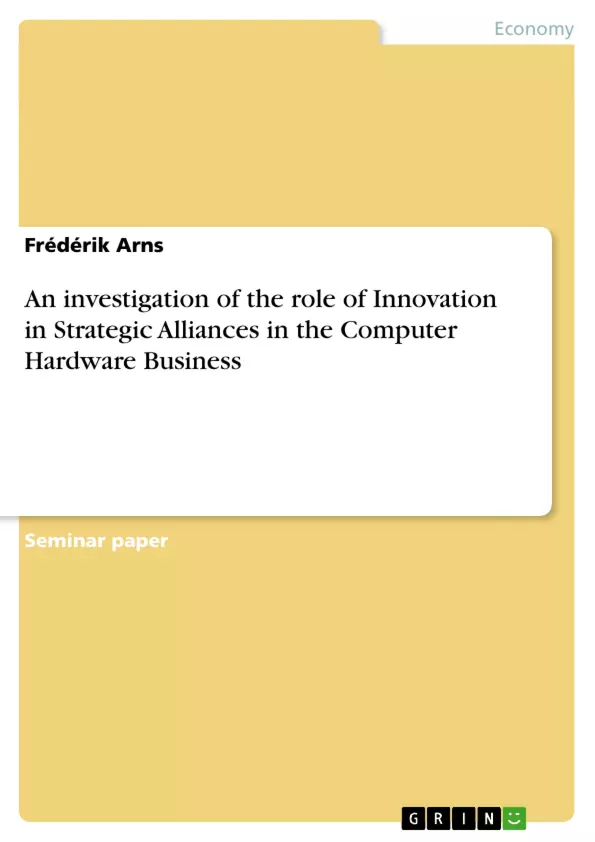In the contemporary business world nobody survives alone. An organization that wants to succeed must follow the rapidly changing environment. Major requirements for successful activity on the market are openness to innovations and the ability to enter into an alliance with other organizations and even competitors.
“Strategic” or “corporate” alliances formed at high levels often fail to deliver real benefits to the partners. Analysts and managers will argue eternally over what caused each link-up to fail. Some blame egos and clashing cultures; others cite business conflicts and ruthless competition. Yet these cases of unfulfilled promises typically share one syndrome: the creation of the big alliance came to be seen as an end in itself rather than a means to a broader strategic goal (Gomes-Casseres, 1998). Therefore, an alliance without a comprehensive strategy behind it has a large probability of failure. Moreover, not all strategies lead to success.
This research involves exploring strategic alliances in the computer hardware sector, the most innovative sector of the economy. Using the example of IBM, I aim to show that a strategic alliance can be successful if it is driven by innovation. In other words, two companies that form an alliance for the purpose of development and advancement of a new product or technology are likely to be successful. Admittedly, the presence of the innovation factor may not necessarily be the main reason for the success of the strategic alliance. Nevertheless, alliances based on joint innovation development are more lasting and productive than those that are not. I also hope to show how innovations help companies determine a strategy for their alliance.
The following section presents a literature review on the strategic alliance, its purpose, and its expectations. The subsequent two sections present the research questions and model the problem, using the EFQM Excellence Model to estimate the success of the strategic alliance in achieving its purpose. The last two sections discuss the methods and data necessary for this study, and then present the conclusion.
Inhaltsverzeichnis (Table of Contents)
- Introduction
- Literature review
- Definition
- Types of alliances
- Alliances in the High-tech industries
- Types of Innovation
- Review of recent IBM alliances
- Research Questions
- Theoretical Model
- Hypothesis 1.
- Hypothesis 2.
- Hypothesis 3.
- Hypothesis 4.
- Methods and Data
- Quantitative Research (or Surveys)
- Qualitative Research
- Conclusions
Zielsetzung und Themenschwerpunkte (Objectives and Key Themes)
The primary objective of this research is to demonstrate that a strategic alliance in the computer hardware business can achieve success through a focus on innovation. The study investigates IBM's strategic alliances with other companies in the computer hardware and software industries, as well as networking, and utilizes the EFQM Excellence Model as a conceptual framework to evaluate the success of these alliances. The research employs both quantitative and qualitative research methods to gather data relevant to the complex research questions posed in the study.
- The role of innovation in strategic alliances
- The effectiveness of strategic alliances in the computer hardware sector
- The application of the EFQM Excellence Model to evaluate strategic alliance success
- The use of quantitative and qualitative research methods in strategic alliance analysis
- The importance of a comprehensive strategy in driving alliance success
Zusammenfassung der Kapitel (Chapter Summaries)
- Introduction: This chapter outlines the study's objective of demonstrating the importance of innovation in achieving success in strategic alliances in the computer hardware sector. It emphasizes the importance of collaboration and innovation in today's business world and highlights the potential pitfalls of alliances without a clear strategic focus. The chapter introduces IBM as the case study and outlines the study's structure.
- Literature Review: This chapter provides a comprehensive overview of strategic alliances, defining them as mutually beneficial long-term relationships between independent organizations. The chapter details the benefits of strategic alliances, including increased capital for research and development, reduced product lead times, access to complementary skills and assets, knowledge transfer, and market expansion. It also explores different types of alliances, ranging from arm's-length contracts to joint ventures, and emphasizes the importance of shared goals and mutual benefit in successful alliances.
- Research Questions: This chapter presents the specific research questions that drive the study. These questions explore the relationship between innovation and strategic alliance success, the factors influencing the success of IBM's alliances, and the applicability of the EFQM Excellence Model to assess alliance performance.
- Theoretical Model: This chapter outlines the conceptual framework for the study, using the EFQM Excellence Model to assess the success of strategic alliances. The chapter presents four hypotheses that underpin the study's analysis, focusing on the influence of innovation on alliance success, the role of organizational factors, and the impact of external factors on alliance performance.
- Methods and Data: This chapter details the research methods employed in the study, highlighting the use of both quantitative and qualitative research approaches. The chapter explains the rationale for using both methods, emphasizing the complexity of the research questions and the need to gather diverse data sources. It outlines the specific data collection strategies used for each method.
Schlüsselwörter (Keywords)
This research focuses on strategic alliances, innovation, computer hardware, the EFQM Excellence Model, quantitative and qualitative research methods, and the case study of IBM. These key terms and concepts provide a foundation for understanding the core themes and objectives of the study.
- Quote paper
- Frédérik Arns (Author), 2005, An investigation of the role of Innovation in Strategic Alliances in the Computer Hardware Business, Munich, GRIN Verlag, https://www.grin.com/document/46711



